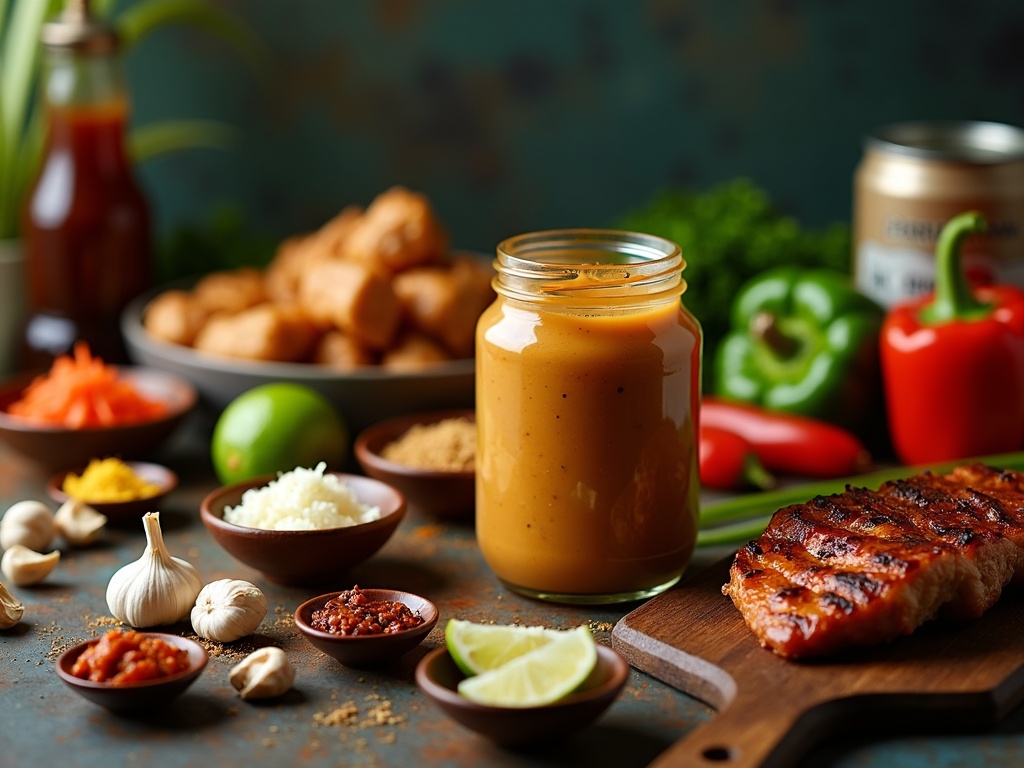Satay sauce recipe, a cornerstone of Southeast Asian cuisine with roots in Indonesia and Malaysia, has evolved from street food staple to global culinary sensation with a 15% consumption increase between 2015-2020. This versatile, peanut-based condiment creates a perfect balance of sweet, savory, tangy, and spicy flavors while offering surprising nutritional benefits alongside its rich taste profile.
Find In This Article
Key Takeaways
- Traditional satay sauce combines ground peanuts, coconut milk, soy sauce, and aromatic spices like lemongrass, galangal, and chili to create complex flavor layers.
- Making authentic satay sauce at home requires simple ingredients including natural peanut butter, coconut milk, soy sauce, lime juice, brown sugar, and aromatics like garlic, ginger, and chili paste.
- The sauce provides significant nutritional benefits with approximately 7g of protein per serving and heart-healthy monounsaturated and polyunsaturated fats.
- Satay sauce versatility extends beyond traditional meat skewers to vegetables, spring rolls, noodles, and even fusion dishes like satay burgers and pasta.
- For those with nut allergies, sunflower seed butter makes an excellent substitute that maintains similar texture and richness.
Origin and Trends
Satay sauce, a rich and flavorful condiment, has deep roots in Southeast Asian cuisine, with Indonesia and Malaysia being its primary birthplaces. This aromatic sauce has traveled far beyond its origins, finding its way onto dinner tables worldwide. In fact, global consumption of satay sauce increased by 15% between 2015 and 2020, showcasing its growing popularity among food enthusiasts.
From Street Food to Global Sensation
I’ve noticed that satay sauce’s journey from humble street food to international culinary star reflects how deeply it’s embedded in Southeast Asian cultural heritage. Walking through the bustling markets of Jakarta or Kuala Lumpur, you’ll find vendors grilling skewered meats and serving them with generous portions of this nutty sauce. These street-side stalls have been preserving cooking traditions passed down through generations.
The sauce’s core components create its distinctive flavor profile:
- Ground peanuts forming the base, providing creaminess and protein
- Coconut milk adding richness and tropical notes
- Soy sauce bringing umami depth and saltiness
- Spices like lemongrass, galangal, and chili creating complex heat layers
What makes satay sauce special is how these ingredients blend to create something greater than their parts. Each region has its own variation – Indonesian versions often lean spicier, while Malaysian recipes might incorporate more lemongrass and galangal.
The growing global appeal of satay sauce isn’t surprising. As more people explore international cuisines, this versatile condiment offers an accessible entry point to Southeast Asian flavors. Its adaptability makes it perfect for dipping, marinating, or drizzling over dishes from chicken to vegetables.
I’ve seen satay sauce evolve beyond its traditional pairing with skewered meats. Creative chefs now incorporate it into fusion dishes like satay burgers, satay pasta, and even satay-inspired pizza. Home cooks appreciate how it transforms simple meals into exotic experiences.
The sauce’s plant-based foundation also aligns with contemporary dietary preferences. With peanuts as the primary ingredient, it offers a protein-rich option for vegetarian and vegan diets. This nutritional profile has helped drive its popularity among health-conscious consumers looking for flavorful alternatives.
For those wanting to experience authentic flavors at home, making satay sauce from scratch provides a deeper connection to Southeast Asian culinary traditions than store-bought versions. The process of roasting peanuts, blending spices, and simmering the sauce fills your kitchen with enticing aromas that transport you straight to the streets of Singapore or Bangkok.
As global palates continue evolving, satay sauce stands as a testament to how traditional recipes can find new life in different cultural contexts. Its journey from local specialty to international favorite demonstrates food’s power to cross borders and bring people together through shared culinary experiences.

Simple Ingredients for Perfect Satay Sauce Recipe
I’ve found that creating authentic satay sauce at home is easier than most people think. With just a handful of simple ingredients, you can whip up a rich, creamy sauce that rivals any restaurant version. The beauty of satay sauce lies in its balance of flavors – sweet, savory, tangy, and spicy all coming together in perfect harmony.
Essential Ingredients for Authentic Flavor
The foundation of any great satay sauce starts with quality peanut butter. I always opt for natural unsweetened peanut butter (1 cup) as it provides the purest flavor without added sugars or oils that might interfere with the authentic taste. Coconut milk (1/3 cup) adds creaminess and a subtle tropical note that’s quintessential to Southeast Asian cooking.
For the savory element, soy sauce (2 tablespoons) brings depth and umami, while lime juice (2 tablespoons) cuts through the richness with its bright acidity. I’ve learned that brown sugar (1 tablespoon) is key for balancing all these strong flavors, creating that perfect sweet-savory profile.
The aromatic components truly elevate homemade satay sauce from good to exceptional. Here’s what I use to build those complex flavors:
- Minced garlic (1 teaspoon) provides a punchy base note
- Ginger paste (1 teaspoon) adds warming, spicy complexity
- Chili paste (1 tablespoon) brings customizable heat
- Curry paste can be added for an extra dimension of flavor
I’ve discovered that the quality of these ingredients matters significantly. Fresh lime juice tastes noticeably better than bottled versions, and freshly minced garlic delivers more aromatic punch than pre-minced options. When selecting coconut milk, I go for full-fat versions in cans rather than the diluted carton varieties meant for drinking.
What makes satay sauce so versatile is how easily you can adjust it to your preferences. If you prefer more heat, add extra chili paste. Craving something sweeter? A touch more brown sugar works perfectly. The sauce can be made thinner with additional coconut milk or thicker by reducing it slightly over low heat.
The magic happens when these ingredients meld together. The fat in the peanut butter and coconut milk creates a luxurious texture that clings beautifully to grilled meats, vegetables, or as a dipping sauce. The acidic lime juice and salty soy sauce balance the richness, while the aromatics and chili provide complexity and depth.
I’ve also found that making the sauce ahead of time improves its flavor profile. Letting it rest for at least 30 minutes allows all those wonderful ingredients to get acquainted with each other, resulting in a more harmonious final product.
For storage, this sauce keeps beautifully in an airtight container in the refrigerator for up to a week. You might notice it thickening when cold – simply warm it gently and add a splash of water or coconut milk to bring it back to your desired consistency.
These simple ingredients create a sauce that’s far more than the sum of its parts. The combination transforms ordinary grilled meats into an exciting, flavor-packed meal that’ll transport you straight to the street food stalls of Southeast Asia.

Quick Steps to Satay Success
Creating the perfect satay sauce doesn’t need to be complicated. I’ve found that with just a few key ingredients and simple techniques, you can whip up a delicious sauce in minutes that rivals any restaurant version.
Building Your Satay Base
I start by combining smooth peanut butter with coconut milk in a medium saucepan over low heat. This creates a velvety foundation that carries all the other flavors. Once the mixture is smooth, I stir in soy sauce for saltiness, lime juice for brightness, brown sugar for sweetness, and minced garlic and ginger for depth. The balance of these ingredients creates that signature sweet-savory profile that makes satay sauce so addictive.
The consistency matters tremendously. If my sauce is too thick, I add a splash more coconut milk or water until it reaches a pourable but clingy texture. For those who enjoy heat, adding chili paste kicks things up significantly—increasing the Scoville units by 200-500 depending on the paste used.
For guests with nut allergies, I’ve discovered sunflower seed butter makes an excellent substitute for peanut butter. It maintains a similar texture and richness while keeping the sauce allergy-friendly.
Some key tips I’ve learned from experience:
- Heat the sauce gently to prevent separation
- Taste as you go—the perfect balance varies based on your peanut butter’s sweetness
- Let the sauce rest for 10 minutes before serving to allow flavors to meld
- Store leftovers in an airtight container for up to 5 days in the refrigerator
The beauty of this sauce lies in its versatility—it’s perfect for dipping chicken skewers, drizzling over rice bowls, or even tossing with noodles for a quick meal. Each batch can be customized to suit your personal taste preferences.
Health Benefits and Nutrition Facts
Satay sauce offers more than just delicious flavor – it packs a nutritional punch that might surprise you. I’ve found that understanding the nutritional profile of this versatile sauce helps me make informed choices about incorporating it into meals.
Nutritional Breakdown
Per 2-tablespoon serving of satay sauce, you’ll typically consume about 190 calories. The caloric content primarily comes from its 16g of fat, much of which derives from peanuts. The sauce also provides 7g of protein and 6g of carbohydrates, making it a relatively balanced condiment option.
These numbers might seem substantial for a sauce, but they reflect the nutrient-dense ingredients used. The high protein content sets satay sauce apart from many other condiments, which often contain minimal protein. This makes it particularly valuable for those looking to increase their protein intake through flavorful additions to meals.
Health Advantages
The fats in satay sauce deserve special attention. According to the USDA, peanut-based sauces contain heart-healthy fats that can support cardiovascular wellness when consumed as part of a balanced diet. These monounsaturated and polyunsaturated fats may help maintain healthy cholesterol levels when replacing saturated fats in your diet.
I consider satay sauce a protein-rich alternative to traditional sauces like mayonnaise or cream-based options. This protein boost makes it especially useful for:
- Adding nutritional value to vegetable dishes
- Enhancing the protein content of plant-based meals
- Creating more satiating snacks when used as a dip
- Providing sustained energy when used in marinades
The peanut base also contributes beneficial micronutrients including vitamin E, niacin, and magnesium. These nutrients support various bodily functions from immune health to energy metabolism.
For those monitoring their sodium intake, it’s worth noting that traditional satay sauce recipes can contain significant amounts of salt. Making your own at home allows you to control sodium levels while maintaining the authentic flavor profile.
When incorporating satay sauce into your diet, portion control remains important. Its nutrient density means a little goes a long way, both in terms of flavor and nutritional contribution. The recommended 2-tablespoon serving provides enough to enjoy the taste and benefits without overwhelming your daily caloric or fat intake.
I’ve found that using satay sauce strategically in meals can enhance not just flavor but nutritional balance. For example, pairing it with fiber-rich vegetables creates a more complete nutritional profile while the healthy fats help with the absorption of fat-soluble vitamins from those vegetables.
For those with specific dietary goals, satay sauce can be adapted. Lower-calorie versions might use powdered peanut butter products, while those seeking higher protein could incorporate additional protein powder. The versatility of the basic recipe allows for personalization based on individual health objectives.
The combination of protein, healthy fats, and moderate carbohydrates makes satay sauce a surprisingly balanced condiment option that can enhance both the flavor and nutritional value of many dishes.
Delicious Ways to Serve Your Satay
Satay sauce transforms ordinary dishes into extraordinary culinary experiences. The rich, nutty flavor profile complements a variety of foods, making it a versatile addition to countless meals. I’ve discovered several delicious ways to serve this flavorful sauce that will elevate your dining experience.
Perfect Pairings for Satay Sauce Recipe
Grilled meats benefit tremendously from a generous drizzle of satay sauce. The smoky char of the meat creates a beautiful contrast with the creamy, slightly sweet sauce. For a complete meal, I often serve skewered chicken or beef with a side of homemade satay sauce for dipping.
Vegetables gain new life when paired with this nutty concoction. Whether you’re serving raw veggies as appetizers or grilled vegetables as a main course, satay sauce adds depth and complexity. I particularly enjoy serving blanched broccoli, carrots, and bell peppers alongside a bowl of satay for a nutritious snack option.
Spring rolls, both fresh and fried varieties, become even more irresistible when dipped in satay sauce. The crispy exterior of fried spring rolls provides a textural contrast to the smooth sauce, while fresh spring rolls benefit from the added flavor dimension.
Traditional pairings include cucumber salad, which offers a refreshing counterpoint to the rich sauce. The cool, crisp cucumber slices balance the intensity of the satay perfectly. Rice cakes also serve as excellent vehicles for enjoying satay sauce, their neutral flavor allowing the sauce’s complex taste to take center stage.
Popular Protein Combinations
Different proteins pair exceptionally well with satay sauce, creating memorable meals for any occasion:
- Chicken satay remains the classic choice, with the tender meat soaking up the flavors beautifully.
- Shrimp satay offers a seafood alternative that cooks quickly and provides a subtle sweetness.
- Tofu satay presents a fantastic vegetarian option, with the porous texture absorbing the sauce effectively.
- Beef satay delivers a more robust flavor that stands up well to the boldness of the sauce.
- Tempeh satay gives a nutty, earthy dimension that complements the sauce naturally.
Street food consumption featuring satay and its accompanying sauce has increased by 20% in urban areas between 2019 and 2023. This statistic highlights satay’s growing popularity as a convenient, flavorful option for busy city dwellers seeking authentic flavors without sacrificing convenience.
I often prepare a large batch of satay sauce to keep in my refrigerator for quick meals throughout the week. It maintains its quality for several days when stored properly in an airtight container. For entertaining, I create a satay station with various proteins and vegetables, allowing guests to customize their experience.
Whether you’re looking to enhance your weeknight dinner rotation or impress guests at your next gathering, satay sauce proves its versatility across numerous applications. The beautiful harmony between the sauce’s complex flavors and simple ingredients makes it a standout addition to countless dishes.
The next time you’re looking to add excitement to your meal, consider reaching for satay sauce – its rich texture and bold flavor profile will transform even the most basic ingredients into something truly special.
Sources:
International Peanut Promotion Board – Understanding Asian Sauces: Satay Sauce
USDA FoodData Central – Nutritional Benefits of Peanuts
World Street Food Congress – The Growth of Global Street Food

